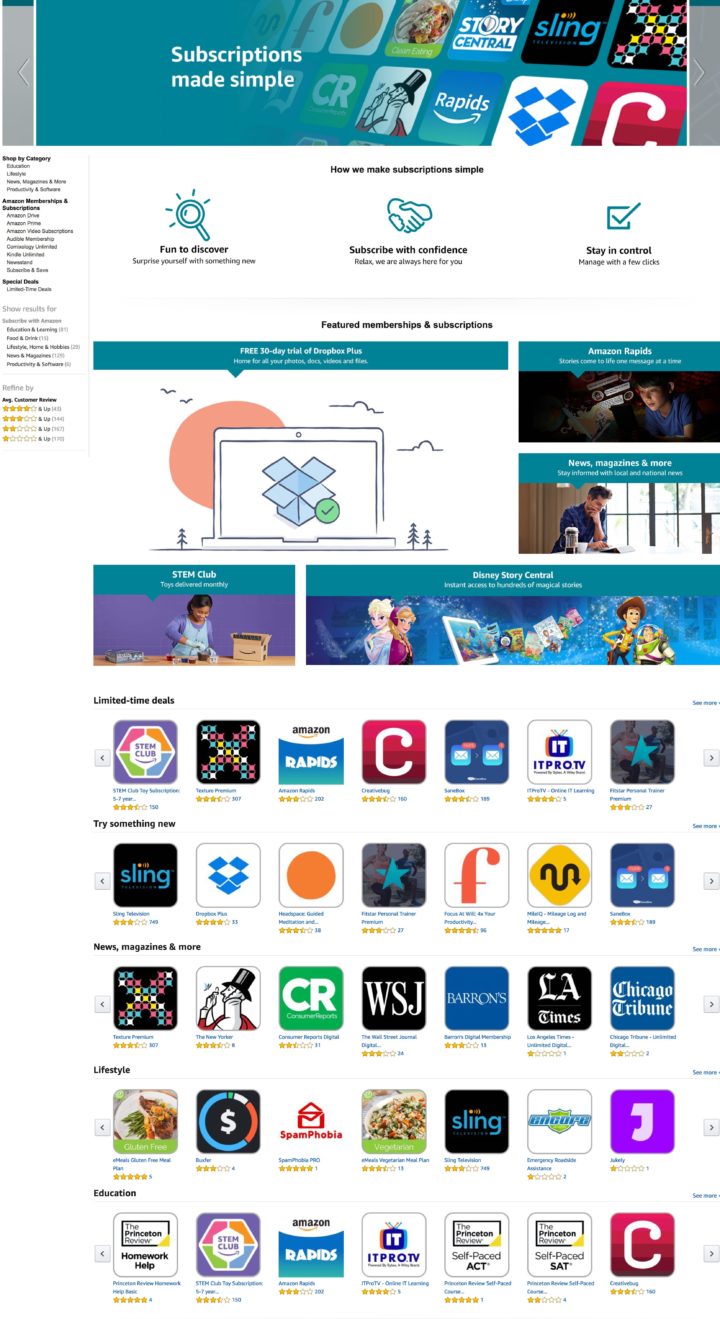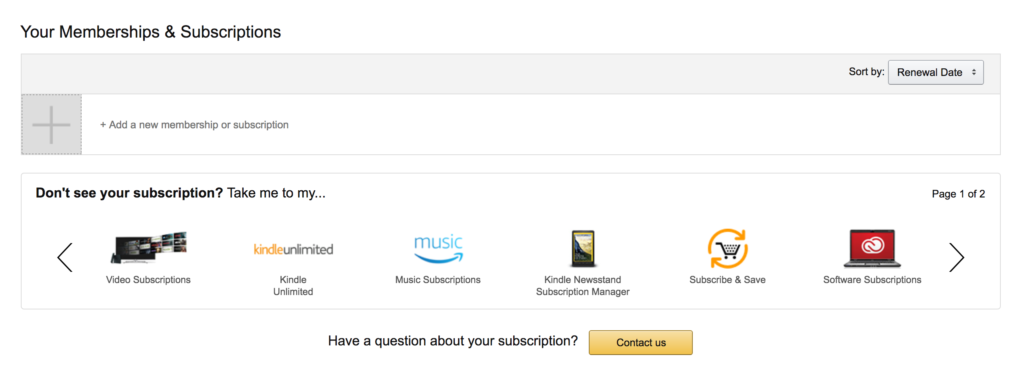Amazon is making waves in the business of consumer subscriptions, and we should all take notice. The launch of Subscribe With Amazon (SWA) is poised to change the way consumers discover, onboard and manage subscription-based services — from mobile apps to video on demand (VOD) platforms, newspapers and magazines. But to understand why SWA is such a significant launch, we first need to understand the problems with consumer subscriptions.
We actually covered this topic in “How subscriptions conquered our world” some months back. In summary, the promise of subscription services is that they give more control to consumers. Lower upfront commitment puts a focus on delivering ongoing customer value across the lifetime of their use of the product. The reality, however, is often different.
With the rapidly growing number of subscription products, certain aspects of the often-hyped “everything-as-a-service” lifestyle are becoming increasingly difficult:
Discovery
Where do I find the best services to subscribe to? While the mobile app stores are optimised for app discovery and eCommerce does a great job of surfacing the best products to impulsively buy next, where do I go to find the latest and greatest subscriptions? Currently, it’s likely to be word of mouth or some form of internet marketing. But I can’t compare products all in one place, or see reviews to understand which meditation app is most suited to my needs, for example.

Payments
Even with consumer billing products like PayPal, Apple Pay et al., payments are a pain for all involved. With no aggregated marketplace to buy subscriptions, I’m left entering my credit card details time after time on different websites and trusting them to handle my transaction securely. Additionally, as it’s subscription billing we’re talking about, we’re trusting these platforms to hold and continue to bill my card on an ongoing basis. Not to mention when my card expires, I have to go back to all these sites and update my card details! The problem here is clear, and painful.
Management
As with payments, the problem of subscription management increases with the number of subscriptions in my life. How many times have you checked your bank statement, only to realise you’ve been passively paying for a service for several months that you weren’t even using? Proof of the reality of this problem exists in the form of several “subscription management” apps now on the market. Some of these apps connect to your bank account and scan for subscription payments for your to review, giving you a simplified list. But they can’t go any further than telling you what you’re currently subscribed to — and leaving it to you to figure out the job of dealing with them.
As Annie wrote in How subscriptions conquered our world, the increased control of a subscription lifestyle is at best, flawed, and quite possibly an illusion.
Enter Amazon — probably one of the only businesses in a position to address all of these problems in one gut-punch of an announcement.
Why Amazon is best-positioned to save us from subscription hell
As you might guess, the problems listed above are not easily solved. Other startups have tried (and failed) to make any headway to date. So what were they missing?
A healthy platform ecosystem: Adding partners to such a platform, with the functionality to manage billing and product features requires deep integration with each partner. As I recently wrote in How to turn a product into a platform, the sheer effort required to kick-start and nurture a healthy ecosystem with good support for developers is huge.
A strong subscription offering of their own: Amazon’s “Retail subscription services” segment — dominated by Amazon Prime — grew to nearly $2B last quarter. Clearly the company understands the power of the recurring revenue model. Amazon Prime is one of the biggest consumer subscriptions on the market.
Partnerships: Whoever wants to succeeds with this solution needs the power and leverage to bring onboard enough of the services on the market to make the platform worthwhile. A subscription management platform with support for a tiny subset of the subscriptions I use is really no use to me.
To become a vendor on such a platform means giving up a great deal of control, particularly for management features. This is a product which makes it far easier for customers to cancel (churn). So in a world where many services require you to jump through a series of confusing dark patterns to even get to the cancel screen, how do you think that deal sounds to them?
Amazon ticks all of the boxes here:
- They have pre-existing relationships with many vendors.
- They’re big enough to hit the required partner coverage for the product to be valuable for users.
- They have a big enough market share such that the benefits of partnering with them (access to new customers) outweigh the downsides (giving up control).
Amazon’s offering
Subscribe With Amazon (still not sure about the name…) is a full-featured marketplace for consumers to discover, sign up for and manage subscriptions to different services. It’s comprised of:
Subscription marketplace (discovery)

Regular users of Amazon.com won’t be surprised here. The storefront for Subscribe With Amazon relies on the tried-and-tested visual framework Amazon has optimized over recent years.
Brand partnerships
The launch of Subscribe With Amazon includes a number of existing popular subscriptions, such as:
- Dropbox
- The Wall Street Journal
- The New Yorker
- The New York Times
- Disney Story Central
- Sling TV
- Headspace
- Jukely
Subscription management
Amazon introduces a new section called Your Membership & Subscriptions under the Your Account menu. Mine looks a little empty right now:

Although it seems incredibly simple, this part of the release is key: For the first time, users are being given a single place to view and manage the subscriptions in their life. (Yes, arguably Apple has done this with the App Store, but it’s horrible to access and vendors are not yet making use of the recently-introduced changes to subscription support.
Vendor signup
While the launch includes a set of pre-selected vendors, Amazon is clearly pushing for a reasonably open signup for new vendors, with their “Sell a subscription” call to action, and the promise to “Reach millions of highly qualified Amazon shoppers.”
Amazon’s SWA Seller Integration Guide (PDF) is a good starting point when it comes to the detailed technical integration with the store.
Vendors have the opportunity to:
- Customize the design for their subscription page on Amazon
- Define their pricing, including support for different tiers
- Offer a free trial through the page
- Set an introductory price for the subscription
- Promote their subscription through the usual Amazon marketing tools
And here’s the revenue share, which is inline with Apple’s new App Store subscription model:
“For a customer’s first year as a subscriber, you receive 70% of each transactional amount.”
“After a subscriber’s first year, your revenue increases to 85% of each transactional amount.”
Why should we care about Subscribe With Amazon?
In many ways, Subscribe With Amazon is a fairly typical display of platform engineering from a company who’s speciality is building platforms. It bares many of the hallmarks present in the launch of other Amazon platforms like Alexa (and the Amazon Echo product) which was launched in 2015 — namely a focus on quantity through “opening the flood gates” to developers. As a result of this, Amazon’s app stores have a problem with low quality, “spammy” or even malicious apps, which they combat through improved discovery and personal recommendations. This is a very different approach to Apple, which focuses on curation and a heavy vetting process throughout App Store submissions.
So if Amazon’s existing platform launches are anything to go by, we should expect an aggressive and open-armed push for vendor adoption on the Subscribe With Amazon store. The success of the platform relies on a healthy selection of popular services, and while some will inevitably hold out, Amazon is well-placed to hit a critical mass.
So is this good for consumers? Well, on the surface, yes. Giving people a single place to view and manage the subscriptions in their life is a compelling reason — as well as the ability to discover new and useful services on the platform. Of course, the flip side of this is that while you’re gaining control over your subscriptions, you’re giving up a greater amount of control to the all-encompassing Amazon eCommerce platform. Whether this leads to decreased competition, increased prices or anti-competitive behavior down the road remains to be seen.
